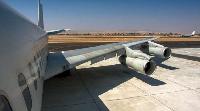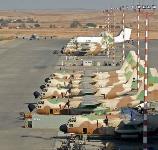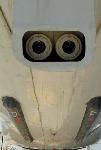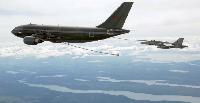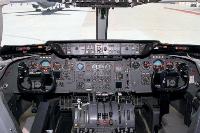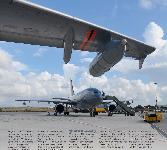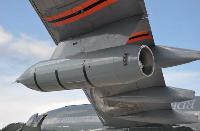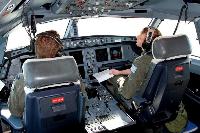Фотографии
-
Israeli Air Force KC-707 Reem 264 refuelling an F-15B Baz with two F-15As in formation.
Самолёты на фотографии: Boeing Boeing 707/720 - США - 1954McDonnell Douglas F-15A/C Eagle - США - 1972McDonnell Douglas F-15B/D Eagle - США - 1972
-
Регистрационный номер: 4X-JYH Israel Air and Space Force Boeing KC-707 Re'em 264/4X-JYH (c/n 20721) arrives at RAF Mildenhall, Suffolk, on August 7, 2013. The aircraft, assigned to 120 Squadron based at Nevatim, passed through Mildenhall on its way home from Greenville, Texas, where it underwent a series of upgrades with L-3 Communications. The large number of aerials on the upper and lower fuselage suggests the aircraft is equipped for roles other than aerial refuelling. Reem 264 was the first Israeli KC-707 to be painted in this dark grey colour scheme.
Самолёты на фотографии: Boeing Boeing 707/720 - США - 1954
-
KC-707s on the flight lines at Air Base 28 Nevatim, home of the IAF Heavy Transport Wing.
Самолёты на фотографии: Boeing Boeing 707/720 - США - 1954
-
No. 120 Desert Giants Squadron is the only unit to fly the KC-707 in the Israeli Air Force.
Самолёты на фотографии: Boeing Boeing 707/720 - США - 1954
-
Three F-16C Barak fighters behind KC-707 Reem 275.
Самолёты на фотографии: Boeing Boeing 707/720 - США - 1954General Dynamics F-16A/C/E Fighting Falcon - США - 1974
-
All of the Israeli Air Force KC-707s are powered by Pratt S Whitney JT3D turbofan engines.
Самолёты на фотографии: Boeing Boeing 707/720 - США - 1954
-
An IAI-developed retractable boom with various cowlings removed for maintenance.
Самолёты на фотографии: Boeing Boeing 707/720 - США - 1954
-
Reem 275 takes off from Air Base 28 Nevatim on a training sortie.
Самолёты на фотографии: Boeing Boeing 707/720 - США - 1954
-
Air Base 28 Nevatim is home to the Israeli Air Force C-130 and KC-707 fleets.
Самолёты на фотографии: Boeing Boeing 707/720 - США - 1954Lockheed C-130 Hercules - США - 1954
-
IAI designed the retractable boom for all Israeli Air Force KC-707 Reem tankers.
Самолёты на фотографии: Boeing Boeing 707/720 - США - 1954
-
Pilot director lights used for signalling to the receiver aircraft are fitted under the KC-707’s rear fuselage.
Самолёты на фотографии: Boeing Boeing 707/720 - США - 1954
-
IAI's KC-707 tanker conversion included installation of fuel tanks in the former passenger cabin.
Самолёты на фотографии: Boeing Boeing 707/720 - США - 1954
-
The KC-707 boom operator’s station is located in the aft cabin.
Самолёты на фотографии: Boeing Boeing 707/720 - США - 1954
-
Left: A schematic diagram of a KC-707 Reem tanker.
Right: Another schematic diagram of a proposed twin-engine replacement for the KC-707.Самолёты на фотографии: Boeing Boeing 707/720 - США - 1954
-
The 422nd Test and Evaluation Squadron ‘Green Bats’ based at Nellis AFB, Nevada provides regular trade to the Travis-based KC-10s. A Green Bats F-16C refuels from a KC-10A Extender over California.
Самолёты на фотографии: General Dynamics F-16A/C/E Fighting Falcon - США - 1974McDonnell Douglas KC-10 Extender - США - 1981
-
Регистрационный номер: A39-005 [2], EC-336 [2], F-WWKN [2] An F/A-18A Hornet assigned to No.3 Squadron Royal Australian Air Force refuels from KC-30A A39-005 over the Pacific Ocean near the island of Guam during this year's exercise Cope North.
Самолёты на фотографии: Airbus A330 MRTT / KC-30 Voyager - International - 2007McDonnell Douglas F/A-18A Hornet - США - 1978
-
A CC-150 Polaris from 437(T) Squadron (part of 8 Wing at Trenton) is escorted by a CF-18 Hornet from 425 Squadron (3 Wing at Bagotville).
Самолёты на фотографии: Airbus A310 - International - 1982McDonnell Douglas F/A-18A Hornet - США - 1978
-
The CC-150T’s early in-flight refuelling trials were carried out by 4 Wing at CFB Cold Lake, Alberta.
Самолёты на фотографии: Airbus A310 - International - 1982McDonnell Douglas F/A-18A Hornet - США - 1978
-
The heart of the KC-10 Extender is a 36ft long air-refuelling boom which is the primary system for transferring fuel to receptacle-equipped receiver aircraft.
Самолёты на фотографии: McDonnell Douglas KC-10 Extender - США - 1981
-
Appropriate markings on the wings of the boom of a KC-10A.
Самолёты на фотографии: McDonnell Douglas KC-10 Extender - США - 1981
-
KC-10A Extender 86-0034 receives fuel from another KC-10 on a training flight from their home station of Travis AFB in northern California. Travis is home of the 60th Air Mobility Wing.
Самолёты на фотографии: McDonnell Douglas KC-10 Extender - США - 1981
-
Top: The air-refuelling operator compartment, located in the lower aft portion of the KC-10’s fuselage, is fitted with two windows on either side.
Below center & Far left: Wing air refuelling pods are fitted to 20 of the 59 KC- 10A Extenders currently in US Air Force service.
Right: All 59 USAF KC-10s are fitted with a hose drum unit (with drogue mounted) located on the underside of the aft starboard fuselage.Самолёты на фотографии: McDonnell Douglas KC-10 Extender - США - 1981
-
KC-10A 86-0034 returns to its parking spot at Travis following a local training mission.
Самолёты на фотографии: McDonnell Douglas KC-10 Extender - США - 1981
-
An airman installs safety wires on the engine mounts of a KC-10 Extender engine.
Самолёты на фотографии: McDonnell Douglas KC-10 Extender - США - 1981
-
Самолёты на фотографии: McDonnell Douglas KC-10 Extender - США - 1981
-
This shot shows the boomer's seating position in the air-refuelling operator compartment, which is located in the lower aft portion of the KC-10’s fuselage.
Самолёты на фотографии: McDonnell Douglas KC-10 Extender - США - 1981
-
The KC-10's cavernous cabin has space for 27 pallets.
Самолёты на фотографии: McDonnell Douglas KC-10 Extender - США - 1981
-
The pilot and co-pilot pay close attention to their tanker aircraft as they move into the pre-contact position.
Самолёты на фотографии: McDonnell Douglas KC-10 Extender - США - 1981
-
US Air Force KC-10s have analogue cockpits.
Самолёты на фотографии: McDonnell Douglas KC-10 Extender - США - 1981
-
The KC-10 flight engineer’s station is fitted with an abundance of switches and dials for monitoring and controlling the aircraft’s systems.
Самолёты на фотографии: McDonnell Douglas KC-10 Extender - США - 1981
-
Air-to-air refuelling of a Tornado ECR from 50° Stormo during qualification trials with the AMI Test Wing.
Самолёты на фотографии: Boeing KC-767 / KC-46 Pegasus - США - 2005Panavia Tornado IDS (GR) - International - 1974
-
Off the coast of Libya at 1800hrs an RAF Tornado GR4, call-sign ‘Psycho 08’, arrives off the starboard wing of ‘Hoser 70’. During the 15-minute ‘hook-up’ the RAF and RCAF crews chatted over the intercom; the RAF crew passing on their recent strike mission details which were relayed to the Combined Air Operations Centre at Poggio Renatico, Northern Italy. The Tornado would return once more to the tanker during its sortie before returning to the RAF’s forward operating base at Gioia del Colle, Italy.
Самолёты на фотографии: Panavia Tornado IDS (GR) - International - 1974
-
A Russian Air Force Il-78M with a TU-95MS Bear bomber
Самолёты на фотографии: Ильюшин Ил-78 - Россия - 1983Туполев Ту-95МС - Россия - 1979
-
Регистрационный номер: KW-3552 A Russian Air Force Il-78M Midas refuels an Indian Air Force A-50EI Mainstay airborne early warning aircraft during flight trials in Russia.
Самолёты на фотографии: Бериев А-50 - Россия - 1984Ильюшин Ил-78 - Россия - 1983
-
Регистрационный номер: RA-78806, СССР-78806 NPP Zvezda's UPAZ-1 pod can transfer 1,000 litres of fuel per minute to tactical aircraft such as the Su-24 Fencer and Su-27 Flanker.
Самолёты на фотографии: Ильюшин Ил-78 - Россия - 1983
-
UPAZ Aerial Refuelling Pod
Самолёты на фотографии: Ильюшин Ил-78 - Россия - 1983
-
A Russian Air Force Il-78M assigned to the 203rd Aviation Regiment takes off from Ryazan-Dyagilevo AB.
Самолёты на фотографии: Ильюшин Ил-78 - Россия - 1983
-
The UPAZ-1 air-refuelling pod is clearly visible on the aft fuselage of this Il-78M Midas taking off from Ryazan-Dyagilevo AB on a snowy winter's day.
Самолёты на фотографии: Ильюшин Ил-78 - Россия - 1983
-
A early version of the Il-78M Midas seen at Zinchuk AB in the Ukraine.
Самолёты на фотографии: Ильюшин Ил-78 - Россия - 1983
-
Two Su-24M Fencer bombers with an Il-78M.
Самолёты на фотографии: Ильюшин Ил-78 - Россия - 1983Сухой Су-24М - Россия - 1977
-
An Su-27UB Flanker plugged into the port side drogue of a Russian Air Force Il-78M Midas.
Самолёты на фотографии: Ильюшин Ил-78 - Россия - 1983Сухой Су-27УБ - Россия - 1985
-
An Il-78M’s digital cockpit.
Самолёты на фотографии: Ильюшин Ил-78 - Россия - 1983
-
The Il-78M’s cargo hold measures 320m3.
Самолёты на фотографии: Ильюшин Ил-78 - Россия - 1983
-
Baking in the Italian midday sun, the Polaris crew open both forward passenger doors to help cool down the aircraft’s interior. Within a few hours this tanker would be off the coast Libya, refuelling NATO fighters.
Самолёты на фотографии: Airbus A310 - International - 1982
-
Polaris 15001 - primarily used to transport members of the Royal Family, the Governor of Canada, and other dignitaries - received a new paint scheme in February 2013 of Arctic white, ocean blue and maple leaf red to better reflect Canada’s national identity.
Самолёты на фотографии: Airbus A310 - International - 1982
-
A single Polaris provided air-to-air refuelling for the CF-18s of the Blue Force during Exercise Maple Flag XLII.
Самолёты на фотографии: Airbus A310 - International - 1982
-
Two Polaris tankers, 15004 and 15005, were deployed to Trapani-Birgi as part of Canada’s Sicily Air Wing. During Operation Unified Protector, the RCAF accomplished 10% of all AAR, a remarkable accomplishment with just two aircraft deployed to the theatre.
Самолёты на фотографии: Airbus A310 - International - 1982
-
One of two wingtip pylon-mounted Cobham Mk.32B hose-and-drogue refuelling pods. At present CF-18 Hornets are the only RCAF aircraft that can receive fuel from the CC-150T.
Самолёты на фотографии: Airbus A310 - International - 1982
-
Members of 437 (Transport) Squadron supported six CF-18 Hornets as part of Operation Ignition, Canada’s contribution to NATO Airborne Surveillance and Interception efforts to meet Iceland’s security needs.
Самолёты на фотографии: Airbus A310 - International - 1982
-
Several highly experienced RAF tanker pilots have undertaken exchange tours with the RCAF to pass on their knowledge of air-to-air refuelling. Here a mixed British and Canadian crew are pictured on a combat sortie off the coast of Libya in 2011.
Самолёты на фотографии: Airbus A310 - International - 1982
-
Регистрационный номер: A39-001 Royal Australian Air Force KC-30A A39-001 seen on takeoff from the Airbus Military's facility at Getafe. Clearly visible is the Aerial Refuelling Boom System (underside of aft fuselage) and the wing-mounted Cobham 905E refuelling pods.
Самолёты на фотографии: Airbus A330 MRTT / KC-30 Voyager - International - 2007
-
Регистрационный номер: A39-005 [2], EC-336 [2], F-WWKN [2] KC-30A A39-005 over the Pacific Ocean on an air-refuelling mission from Andersen AFB, Guam during exercise Cope North in February 2013. All Royal Australian Air Force KC-30As wear No.33 Squadron’s badge featuring a Frigatebird on the tail.
Самолёты на фотографии: Airbus A330 MRTT / KC-30 Voyager - International - 2007
-
Регистрационный номер: A44-217 Royal Australian Air Force F/A-18F Super Hornet A44-217 formates on the port side wing of a KC-30A prior to air refuelling during exercise Talisman Saber 2013.
Самолёты на фотографии: Airbus A330 MRTT / KC-30 Voyager - International - 2007McDonnell Douglas F/A-18F Super Hornet - США - 1995
-
A KC-30A at RAAF Base Amberley, home of No.33 Squadron.
Самолёты на фотографии: Airbus A330 MRTT / KC-30 Voyager - International - 2007
-
A Pilot’s eye view of a KC-30A’s drogue from an F/A-18F Super Hornet assigned No. 1 Squadron.
Самолёты на фотографии: Airbus A330 MRTT / KC-30 Voyager - International - 2007McDonnell Douglas F/A-18F Super Hornet - США - 1995
-
Самолёты на фотографии: Airbus A330 MRTT / KC-30 Voyager - International - 2007
-
Australia’s KC-30As are fitted with a comfortable all-digital flight deck.
Самолёты на фотографии: Airbus A330 MRTT / KC-30 Voyager - International - 2007
-
A KC-767A refuelling two 4° Stormo TF-2000S from the Smiths Aerospace wing pods.
Самолёты на фотографии: Boeing KC-767 / KC-46 Pegasus - США - 2005Eurofighter Typhoon T / TF-2000 - International - 1997
-
A KC-767A over snowed mountains in central Italy.
Самолёты на фотографии: Boeing KC-767 / KC-46 Pegasus - США - 2005
-
Uploading cargo;
Самолёты на фотографии: Boeing KC-767 / KC-46 Pegasus - США - 2005
-
The rigid boom below the aft fuselage and the cameras used for air-to-air refuelling positioned between the main landing gears;
Самолёты на фотографии: Boeing KC-767 / KC-46 Pegasus - США - 2005
-
Close-up of the Smiths Aerospace IFR pod.
Самолёты на фотографии: Boeing KC-767 / KC-46 Pegasus - США - 2005
-
Two rearward facing Remote Air Fueling Operator stations are located behind the KC-767’s cockpit.
Самолёты на фотографии: Boeing KC-767 / KC-46 Pegasus - США - 2005
-
The KC-767's cockpit has a state-of-the-art avionics suite, dominated by six colour MFDs;
Самолёты на фотографии: Boeing KC-767 / KC-46 Pegasus - США - 2005
Статьи
- -
- News
- Tankers (1)
- M.Broadbent - Resurgence of Low-Cost, Long-Haul /Commercial/
- N.Pittaway - Advanced Super Hornet /Military/
- N.Pittaway - Bells on Tour /Commercial/
- N.Pittaway - Talisman Saber 2013 /Military/
- P.Butowski - Maxing Out at MAKS /Military/
- P.Butowski - Next Gen MiG /Military/
- S.Bennett - Killing Them Softly /Military/
- S.Dworkin - The Grease, The Grit, The Grind /Military/





